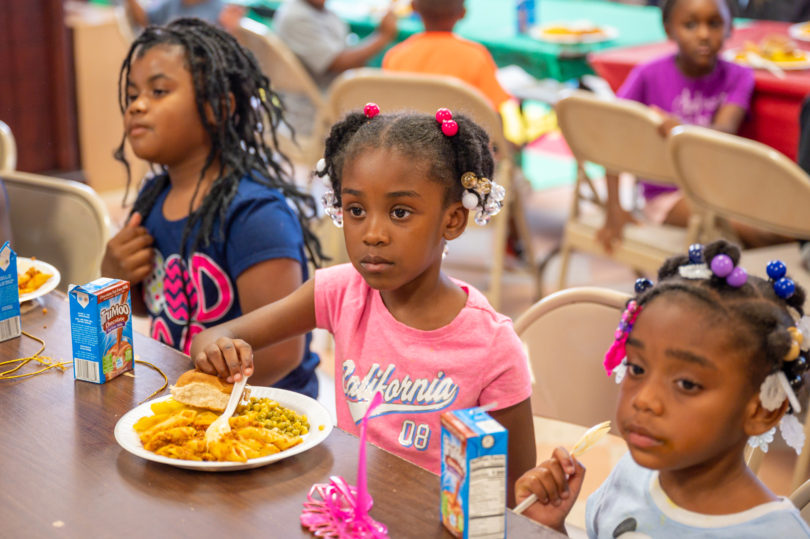A child goes to school ready to learn because she’s eaten a healthy breakfast. A senior doesn’t have to choose between paying for food or for prescription medication. A family can put bread on the table while the breadwinner is between jobs.
All that can happen from a bag of groceries from the Virginia Peninsula Foodbank.
The Virginia Peninsula Foodbank, located in Hampton, Va., distributed 750,000 pounds of food in 1986, the year it was founded as a branch of the Foodbank of Southeastern Virginia. Since then, the food bank has significantly increased its food distribution — last year, it gave out 11.8 million pounds of food.
At times, the work is challenging. All the food that comes in to or goes out from the food bank must be weighed, handled and stored according to food safety guidelines. It’s sometimes a struggle between the ease of donated shelf-stable pantry food items and more nutritious but expensive and perishable produce. It’s a constant battle to get produce in particular through the warehouse and to those in need before it goes bad. And then, there is the matter of soliciting donations — always hoping there’s enough coming in to feed everyone.
It’s a massive undertaking, but one that Karen Joyner, the Virginia Peninsula Foodbank’s chief executive officer, says she, her staff and volunteers are up to tackling.
“You feed the people who are in front of you and you feed as many as you can,” Joyner says.
Much of the food bank’s work goes unseen by the general public. But without it, so many smaller food pantries would run dry. Approximately 80 percent of the work the food bank does is to collect food from donors like grocery stores and restaurants and distribute it to its partner agencies such as food pantries and homeless shelters. The food bank works with about 200 partner agencies who then distribute it to those in need.
“As long as we can get the food in, we can get the food out,” Joyner says.
When the food bank became independent in 1987, the staff hoped to put up a canopy off the loading dock to protect it from the rain. Today, the food bank is housed in a purpose-built warehouse finished in 2010. The sheer scale of the warehouse is always a bit of a shock to visitors, Joyner says. It’s so large it can hold up to 2.5 million pounds of food at once.
While the food bank works on a gigantic scale, it’s the human scale which drives Joyner and everyone else who works or volunteers there. One in three of its recipients is a child.
The food bank has some programs which give food directly to kids, like the Kids Café, which feeds hot meals to children at certain sites in the region, and a BackPack Program, which sends bags of food home with at-risk kids on weekends. These programs, however, make up less than 5 percent of the work of the food bank. Most of the time food gets to children through distributions of food to families as a whole. The food bank — or one of its partner agencies — also runs a once-a-month mobile food pantry, which allows fresh fruits, vegetables and meats to get directly to those in need, in neighborhoods that might not otherwise be reached.
The food bank also plays a vital role in preventing food waste. Grocery stores, including Food Lion, Walmart and Kroger, in addition to donating shelf-stable food, donate perishable food that isn’t quite good enough to sell to customers but is still perfectly safe to eat.
When Farm Fresh — the food bank’s third largest donor — closed several stores on the Peninsula, it took a toll on the food bank. The grocery chain had donated about a million pounds of food in 2017-2018, leaving a shortfall in donations. But thanks to the generosity of their donors, particularly newcomer Kroger, they’ve almost been able to make up the shortfall this year, Joyner says.
Still, donations — and donations of money in particular — are a constant struggle, as it often is for nonprofits. “Our utility bill is over $5,000 a month,” Joyner explains, gesturing to the gigantic complex of refrigerator and freezer units. But without their warehouse facility, the food bank couldn’t run.
There are other benefits of cash donations, too. “We can distribute four meals with every dollar that we get because we can often get a truckload of food donated to us if we pay the freight charges,” Joyner says. “We also have great connections where we can buy food a lot cheaper than anybody else.”
Joyner’s goals are modest as she looks toward the food bank’s future. She wants to make sure there’s always enough food to meet the demands of everyone. She hopes the level of donations is there to sustain the organization year after year. And she imagines a day when maybe, the food bank isn’t needed as much. But until then, she says, the Virginia Peninsula Foodbank will be there.
“I would like to think we would have fewer people who would need our help,” she says, “but everyone needs a little help now and then.”
Virginia Peninsula Foodbank By The Numbers
Pounds of food distributed
1986: 750,000
2017-18: 12.1 million
2018-19: 11.8 million
Square feet of
Shelving: 33,000
Refrigerated storage: 2,400
Freezer storage: 3,000
Utility bill each month:
over $5,000
Number of people served who are chronically food insecure:
71,000
Number of people served occasionally:
70,000-80,000
Overall capacity:
2.5 million pounds of food
To make a monetary donation to the Virginia Peninsula Foodbank, or to find a location to drop off non-perishable food donations, visit hrfoodbank.org. Visit the websites’s “Giving” section for information on how to volunteer or set up your own food drive.



